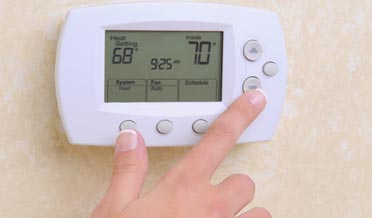AC Maintenance: Troubleshooting Your Thermostat
As Fall approaches, our homes will transition slowly from the cooling season to the heating season. Your air conditioner worked hard all summer long—this was a hot summer. Fall promises to be as warm as you remember from last year.
Perhaps you prefer this transition to happen sooner rather than later, but be patient, the change is coming. This transition is a perfect opportunity to give your HVAC system some attention and care.
How has your HVAC system performed over the last year? Does it cool adequately, even during extreme weather? Does the air seem a little stuffy and humid? Has your utility bill suddenly increased? Here are three short AC Maintenance investigations that you can make to help improve air conditioning function.
AC Maintenance: Getting the Thermostat Right
The connection between your indoor space and the air conditioner is the thermostat. It houses a sensor that detects slight changes in the air temperature and a switch that calls for cold air begins the cooling cycle. After 5 to 10 minutes of cooling, the thermostat registers the change in air temperature and switches the air conditioner off.
A simple key for the thermostat function is putting it in the right location. If it is installed on an outside wall, the radiant heat moving through the wall can cause excess cooling. If the thermostat receives direct sunlight, the solar energy can call for more cooling cycles than necessary.
The placement of the thermostat is very important—on an inside wall, but not in direct sunlight. Thermostats are often placed in hallways, ensuring plenty of family traffic, with the potential for physical contact that can change settings. So, investigate your thermostat to make sure it is positioned properly and is not being changed by accidental contact.
Another thermostat investigation is to consider an upgrade. If you still have an analog thermostat, it is time for an upgrade. If your HVAC system was replaced but your thermostat was not, you might have more technology in your system than your thermostat can handle.
New thermostats are programmable and interactive, so explore your choices. Remember that electronic thermostats require batteries that will need to be replaced; schedule their change at the same time you replace batteries in smoke detectors.
AC Maintenance: Getting the Condenser Right
The condenser unit is the outdoor component of the HVAC system. The function of the condenser is essential for air conditioner function and proper function requires some gentle care.
The position of the condenser is just as important as the thermostat on the inside of the home. The purpose of the condenser is the transfer of the heat from inside the home to the outside. A refrigerant gas collects the heat and when it reaches the condenser it is a whopping 1200 to 1400 F.
This heat must be dissipated quickly since this gas will be recycled to collect even more heat. Although the walls of the condenser look solid, they are composed of a network of coils, connected to very thin fins. This design is to give maximum exposure to air. A large fan in the center pulls air through the network and out of the top.
Since air movement is essential to the function of the condenser, there needs to be no obstacles to hinder airflow. Walk around the condenser and make sure there is at least 2’ of space of open air on every side of the condenser. Have shrubs or tall grass grown too close? Have leaves blown against the condenser? Remove anything that hinders the free flow of air.
Since the central fan is pulling air through the network, it tends to draw airborne objects onto the surface of the network. Grass clippings, pollen, and dust collect on the surface and get caught between the fins and tubes.
Removing this debris improves condenser function; ignoring the debris can lead to an overheated compressor—a catastrophic mistake. Use a garden hose at least once annually to thoroughly clean the debris away. Don’t use a power washer since this can damage the fins and inhibit airflow.
AC Maintenance: Getting the Dust Removed
The V in HVAC refers to ventilation—steps taken to ensure indoor air is fresh and clean. That includes an air filter and an indoor network of ducts.
Air filters continuously remove a collection of skin cells, dander, pet hair, pollen, and mold spores—collectively called dust. Since the filter is effective, the collected dust will eventually clog the filter and restrict airflow. The restriction causes air conditioning performance to decrease, which adds humidity to the indoor air.
The most common AC Maintenance recommendation for air filter replacement is every three months. Investigate this for yourself by checking the filter once per month to determine how quickly the filter needs to be changed, then change the filter as needed.
Thermostat not working? It is time for an AC Maintenance appointment, Call us today!
Contact our AC maintenance team at Doctor Cool & Professor Heat today at 281-338-8751 or email Doctor Cool and let our professional Residential AC Repair technicians assist with all of your HVAC maintenance questions.

